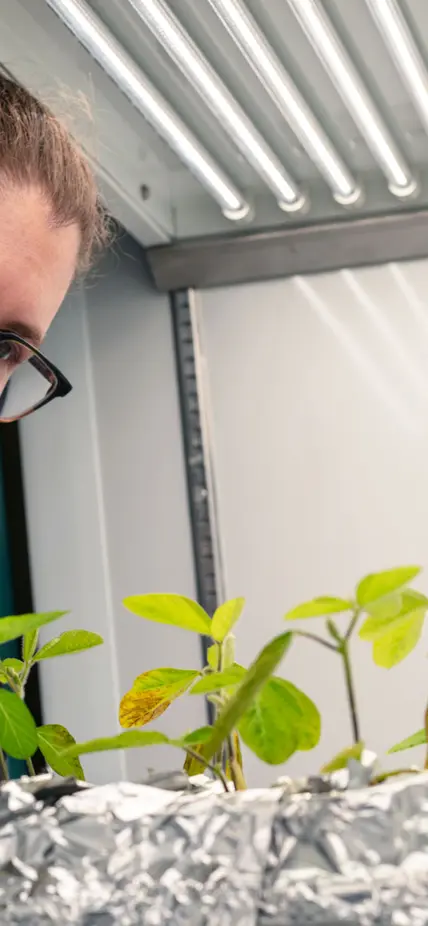Q: Can you give me an overview of the questions that your lab is working on?
Brittany Belin: My lab is interested in the biology of soil bacteria, and we're divided into two major areas of investigation. Half of the lab is working on the role of bacteria in symbiotic relationships with legumes such as peanuts, soybeans—really, any type of bean plant. Those are the plants we grow in the lab, but there are a lot of plants you probably didn't know are legumes, too, like licorice, tamarind, and mesquite.
We focus on the exchange of chemical signals between the bacteria, soil, and legumes. For example, the plants release sugars, nitrogen, and antibiotics into the soil, to which different bacteria have different responses. The bacteria can feed on these compounds, swim toward them, or release their own signals in response that allow the plant to distinguish between helpful and harmful bacteria. We look at these types of responses.
The other half of my lab tries to answer fundamental questions in bacterial cell biology. We study a group of fats called hopanoids, which are analogs of cholesterol. Bacteria, generally speaking, don't make cholesterol, but many make hopanoids instead. Although cholesterol is sometimes a “scary” word in medicine, it’s essential for many different processes in animal cells, including human cells. For example, cholesterol is important for our immune cells to recognize infections, so we're trying to understand whether or not hopanoids are just as important to bacteria. There are human pathogens that make hopanoids, and we know that if you block hopanoids from being produced in these harmful bacteria, they're not as infectious. So, there's potential in studying hopanoids to not only understand bacteria in soil but also to understand more about the pathogenic microbes that infect humans.
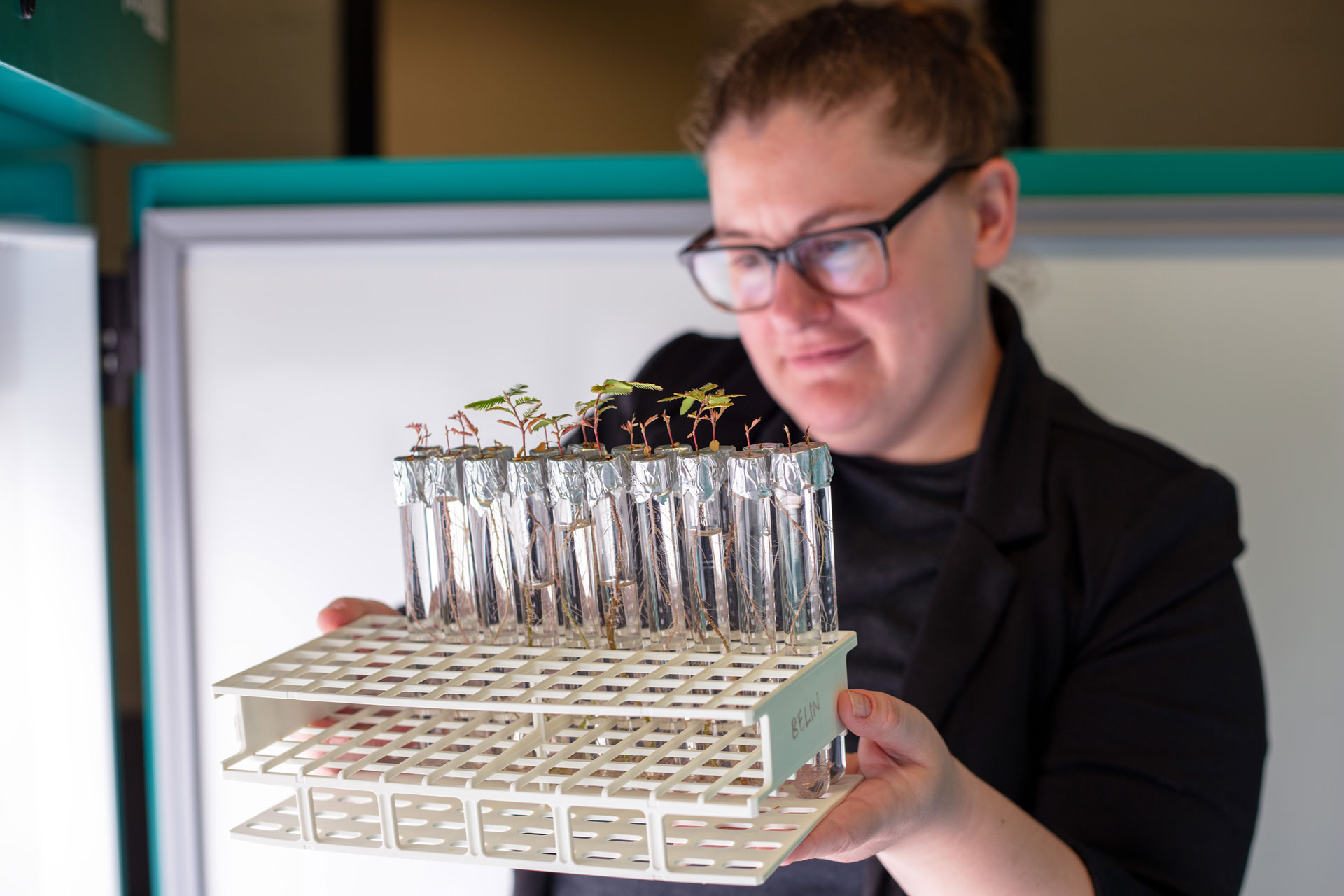
Q: On the agricultural side of things, why is it important to understand these relationships?
Brittany Belin: The bacteria we study are major “green” fertilizers. Our bacteria colonize the plant roots on legumes and secrete chemicals that allow plants to know they have a compatible symbiont present. In response, the plants will grow a whole new organ called a root nodule, and within this nodule, an exchange occurs. The bacteria get sugars that they need to survive, which the plant is able to produce by converting the Sun’s energy into chemical energy via photosynthesis. In exchange, the bacteria can take the nitrogen gas from the atmosphere and turn it into “miracle grow” nitrogen fertilizer. So, they're each providing a metabolic product the other partner doesn't have. This is important for agriculture because when farmers grow legumes, they don’t need as much industrial fertilizer, which can be really bad for the environment.
Bacteria can help crop plants in other ways, too. Now we're learning that there are tons of interactions between every single plant growing in the soil and the bacteria surrounding them that are really important for plant health, even if they aren’t as easy to see by eye as a root nodule. Some bacteria can help protect against pathogens and pests, such as worms and insects, and they can help plants tolerate heat or cold or poor soils. We don’t know how the bacteria are able to do this in a lot of cases, which is why it’s so important to study soil microbes.
Q: How can this information be harnessed for farmers?
Brittany Belin: Farmers have known for a long time about the benefits of symbiosis, even if they didn’t know its exact nature. They understood that it was beneficial because they saw that if you plant soybeans first and then plant corn later, the corn will do better; this is the basis of crop rotation. It would be better if farmers could rely more on legume crops, but that would only be viable if people started consuming lots more beans (which I support!)
Many companies are trying to commercialize beneficial soil bacteria by supplying seeds to farmers coated with a powdered form of microbes or selling bacterial cultures you can spray on the soil. Often, these microbes are genetically modified, and there's a lot of debate within the scientific community about whether that’s a good idea.
We've learned that natural microbial and plant communities have evolved to be very robust, so if there's a change in the environment or a new pest that comes in and invades, they can spring back from that pretty well. But whenever you introduce something you've engineered to function differently, you worry that you'll make that community less resilient over time, even if there are short-term gains. It’s important that there continues to be a back-and-forth discussion between commercialization and conservation, especially because agricultural microbes now represent the fastest-growing sector in biotech.
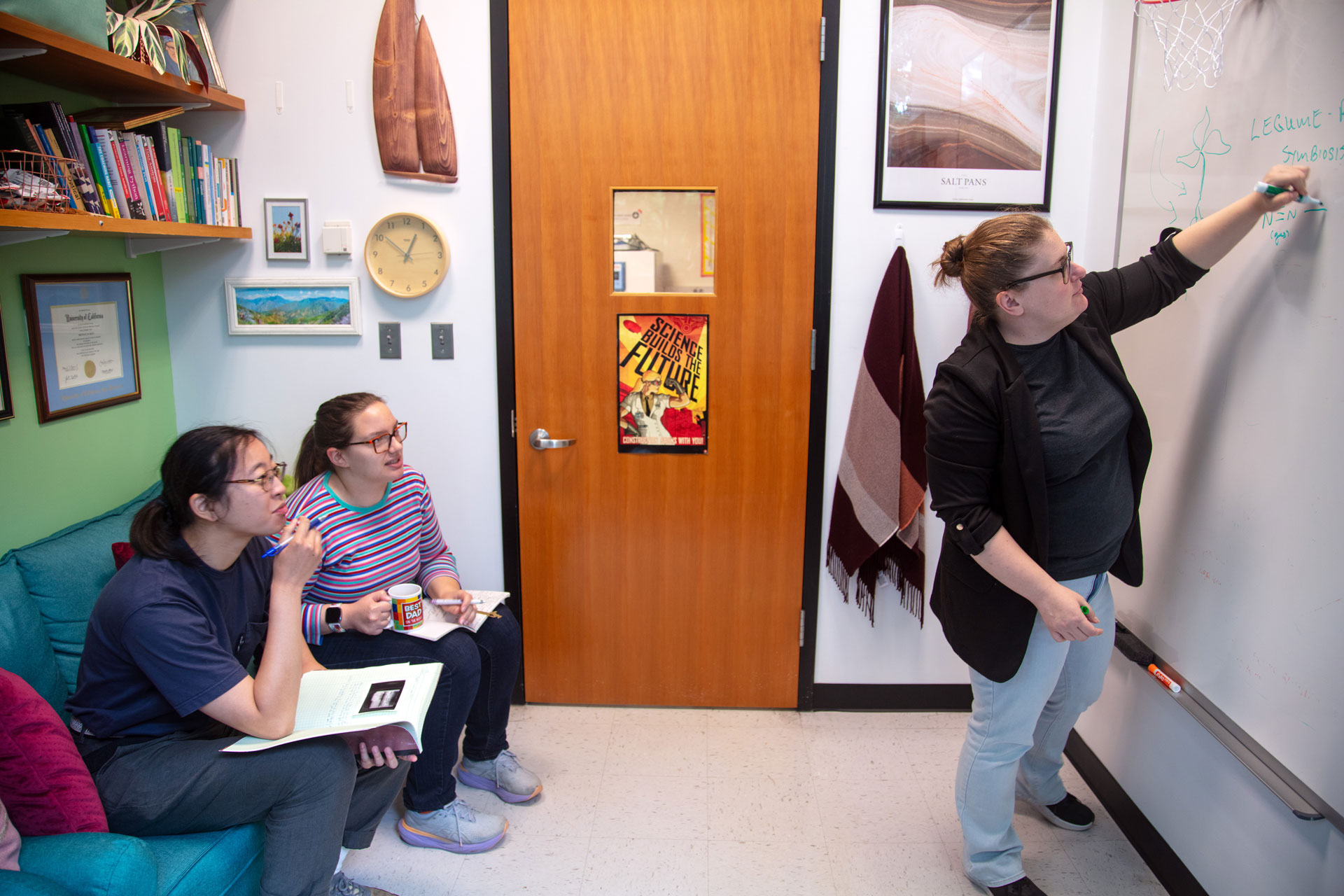
Q: What does a typical day of research look like for you in your lab?
Brittany Belin: I spend most of my time mentoring the people in my lab. I meet with everybody one-on-one every week, and we talk about where they are in their projects, review their data, and discuss how they're designing their experiments to see if there are any issues we can figure out together. Writing grants and coordinating with colleagues and collaborators are other big parts of my day, and I also do a lot of volunteer teaching. I recently went to give a guest lecture at Towson University in their environmental microbiology course, which is a really terrific place for undergrads to learn how to do science, but they don't have the same research opportunities that we have at Carnegie Science. It's exciting to go and talk to them about what we do.
I just finished co-teaching a bacterial cell and developmental biology course at the Johns Hopkins University Medical School and teaching a proposal writing course for graduate students at Hopkins, a course I developed when I started at Carnegie. I’m especially proud of that course because the students nominated me for the Hopkins Excellence in Graduate Teaching & Mentoring award, which I won last year.
Q: What led you to biological research?
Brittany Belin: A lot of it was chance and serendipity. I think we don't appreciate the role of those things as much as we should. A lot of students think that all scientists know what they want to do with 100 percent certainty as if it were predestined, but usually, it’s not true.
I was lucky to have a pretty cool research experience in high school, where I got to do research for a summer at Carnegie Mellon University. They used to have a program called the Governor's Schools in Pennsylvania, a free state-supported program that students could apply to attend. I remember there was a science program, and also political science, international relations, and drama.
I didn't get into the international relations program, but I did get into the science one, so that’s where I went. I learned how to do mass spec and proteomics and got to write up my findings as if I were writing a paper and present them to CMU faculty. That was a moment where I thought, “Hmm, that was kinda cool. Maybe I could do research someday,” though I was still very interested in the humanities, too.
When I was applying to college, I decided to go to Notre Dame because you didn’t have to declare a major in your first year, so I felt I’d have a little more time to decide. You still had to put a hypothetical future major on the form, so I got a Manila envelope and a bunch of index cards and wrote different majors on them. I had pretty much everything in there. I put them all in, shook them up, and drew biochemistry, and that's what I majored in, although I did add a second major in philosophy after I started, which I also completed.
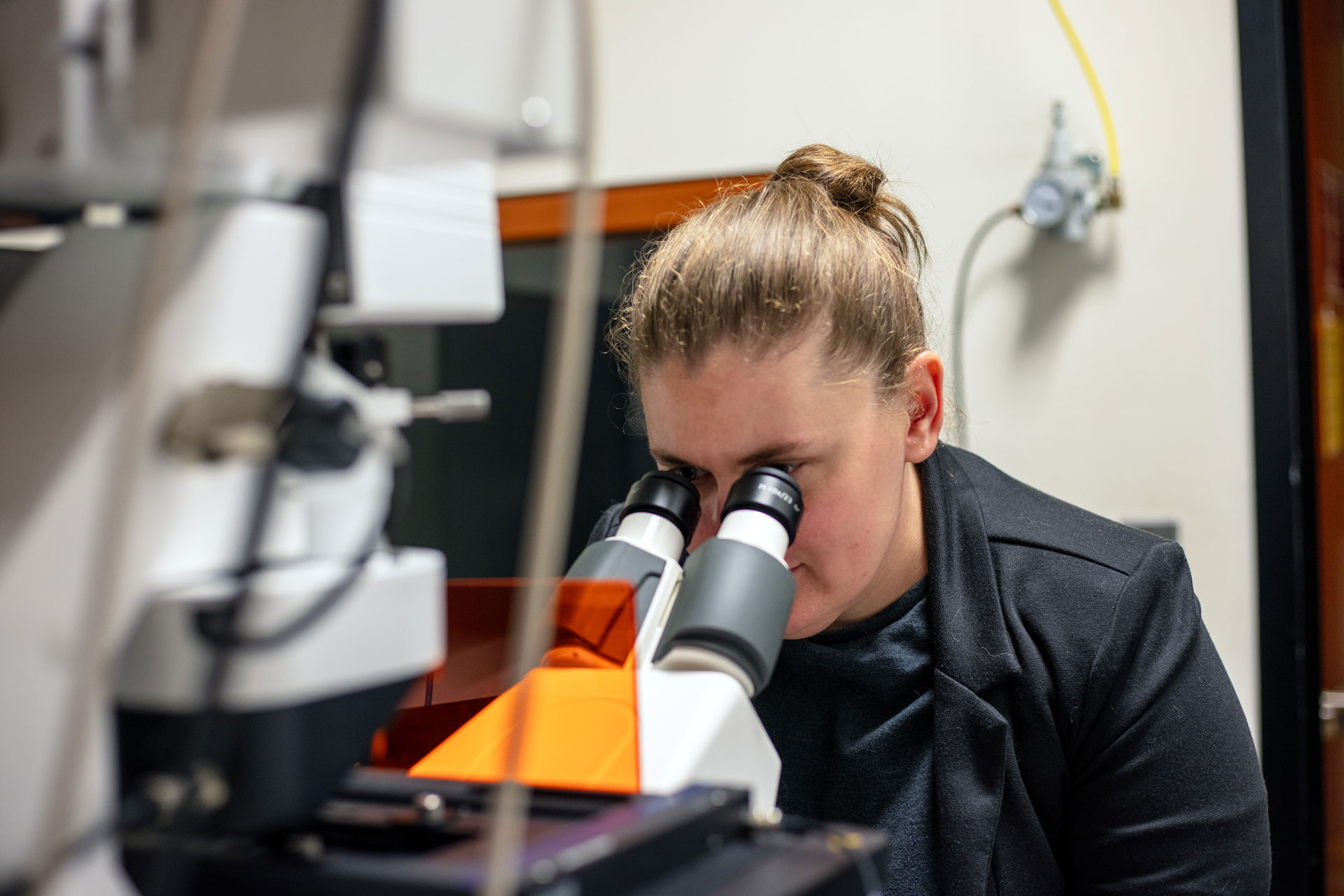
Q: How do you decide what questions to tackle in your research?
Brittany Belin: Well, the first thing is always curiosity. Is the question something that I'm personally excited about? The second factor is more organic—these ideas that come up in our lab meetings, conversations, or seminars. I might see someone explaining how a process works in their bacterium and think: I wonder how it works in ours? Or maybe they're talking about a new method or a technique, and I think about how it could help me answer a question in our system. As a personal preference, I also like the questions that other people aren't asking. I think if too many people were trying to do the same research in the same way as I was doing, then I would go do something else.
Q: What are some significant challenges in harnessing beneficial bacteria for agricultural applications?
Brittany Belin: A big challenge is communicating the research we're doing to farmers and seeing how our ideas actually work in the field. In the lab, we can say: This is the perfect formulation of microbes to get soybeans to grow. But when you put it in the actual field, there are all these other variables that you didn't think about. They've got a different type of soil structure or toxicity. Or maybe the weather was very unusual that year. From a farmer's perspective, if they go to a conference and hear from their colleagues about a product that didn't work, they will be suspicious of similar solutions. A big part of applying these products is partnering with farmers in a way where the products' potential value is communicated while being realistic about the challenges. We need better channels for working with and getting feedback from farmers about what works.
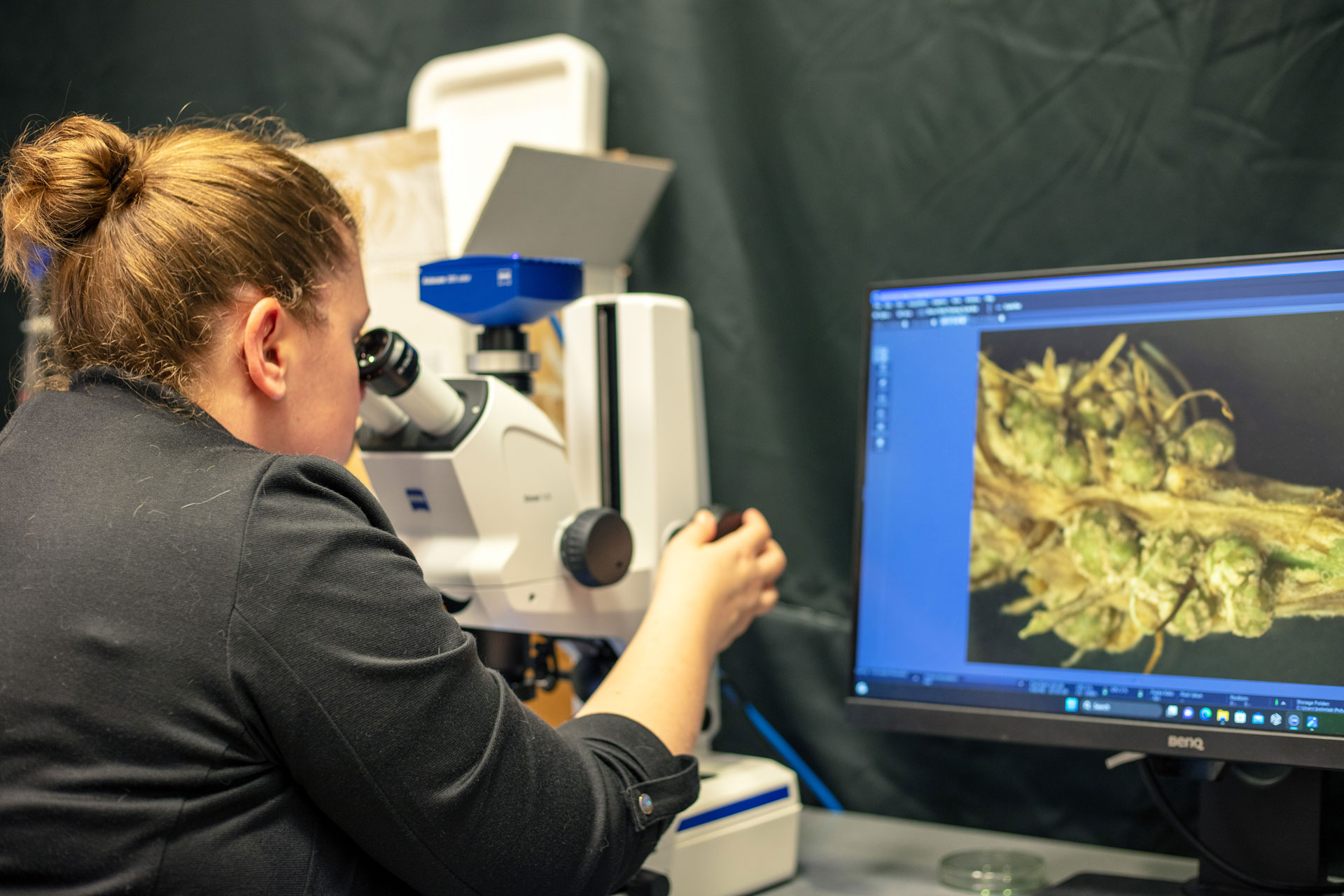
Q: What are the latest technologies that you're using to study the interactions between bacteria and legumes?
Brittany Belin: Mostly, it's on the microscopy side of my lab. I absolutely love microscopes. We’re currently using super-resolution microscopy techniques to see where the proteins and lipids are inside a single bacterial cell, which you couldn't do until recently.
I'm starting to talk to people at the Carnegie Science Earth and Planets Laboratory because they have even higher-resolution instruments that can see single atom isotopes. They use it in rocks, but we’re hoping to use it to look at the transfer of signals between a microbe and its host.
Q: How can the public and policymakers better support research in microbial agriculture?
Brittany Belin: More funding! I think that, right now, most of the educated public is aware that we will have a food crisis if we don't do something about it. The population is increasing, especially in the areas where agriculture is already stressed. In West Africa, for example, the soils are poor and over-farmed, but the population is exploding. Buying commercial fertilizer there is prohibitively expensive. And we're on track to have more frequent, severe weather events that will mess up infrastructure and worsen the problem.
If we don't find ways to make agricultural production more sustainable, then in the next century, we're going to hit a point where food scarcity will become a problem—and many things will come with that. It’s not just starvation; you will have more fighting for food resources, which can mean more war. This is something in which there is philanthropic interest, but in the US, funding from the government—which is our most reliable source of funding for basic discovery science—has lagged.
Some of that is just because climate change is a politicized topic, and it’s frustrating to see the consequences as a microbiologist. When you go to microbiology conferences, 80-90 percent of the talks will be about bacteria that cause human disease because you can get two, three, or more times as much funding as you can for soil microbes. So, most of what the microbes living in the soil do is a mystery because scientists can’t get enough money to study them, which is a real shame since they might be some of our best tools for avoiding agricultural and environmental catastrophes.
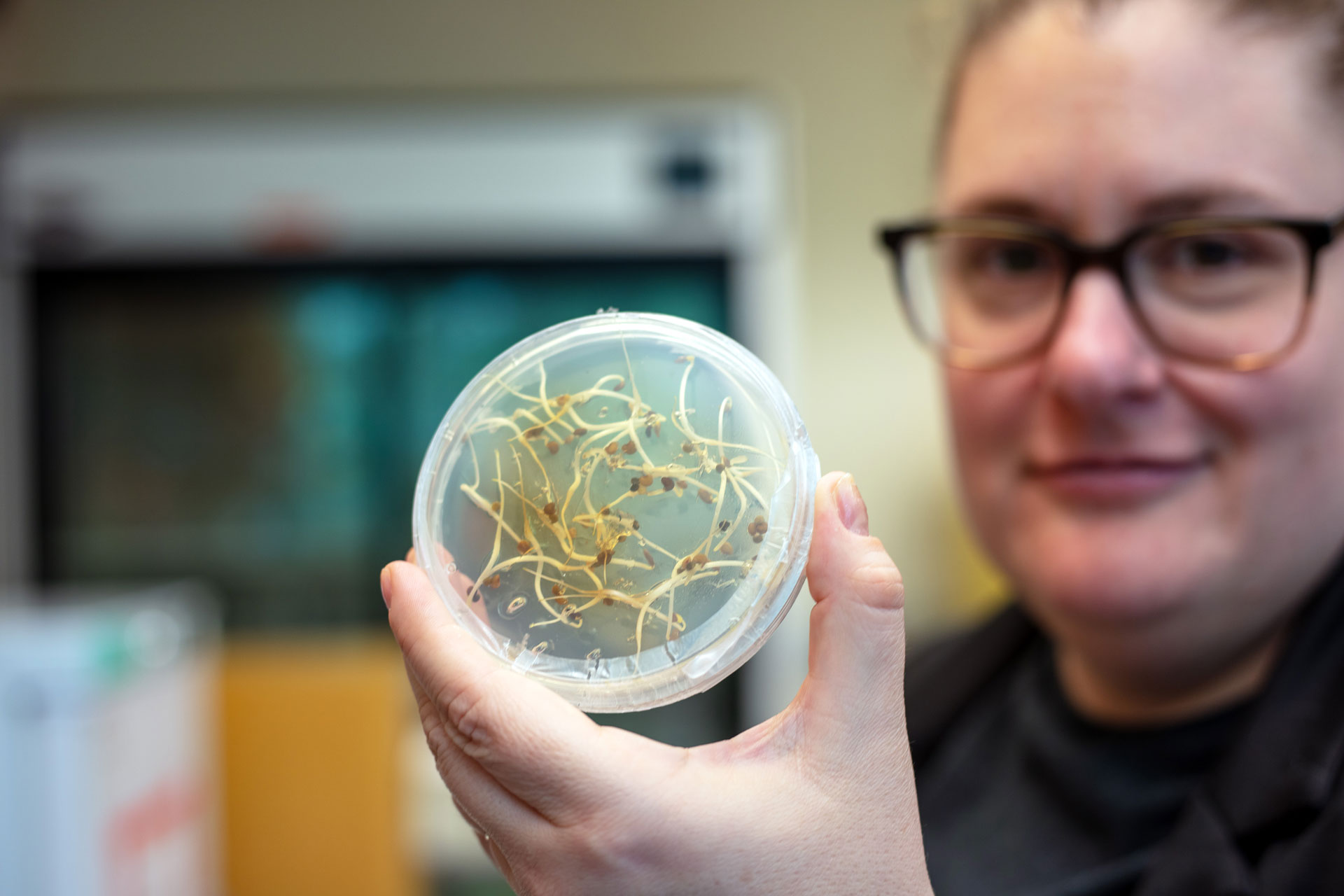
Q: Do you see any potential new technology on the horizon that would be a game-changer?
Brittany Belin: I think there’s a lot of potential in increasing the complexity of the systems we can study in the lab, moving from just one microbe to a community of microbes. We have good microscopy tools now for looking at and detecting single microbes, but it gets tricky to distinguish if you have more than 5–10 members of the community—which is still way fewer members than in real soil. Having new ways to uniquely label large numbers of different microbes while keeping them alive, and studying them in a community setting that looks more like soil than a test tube will be a game-changer.
The research community is moving in that direction, but it’s going to be really hard to connect what’s happening in communities to what is happening within each cell of the community. One of the things that I wish we could do is to look at live cells on a microscope and see how they move and grow at the highest possible resolution while simultaneously knowing all of its gene expression information. In general, it’s hard to connect genomics or population-level information to molecular information in real-time.
Q: What would it take for that to be real? Can it happen?
Brittany Belin: I don't know that it's realistic for it to ever happen. I just want it!
